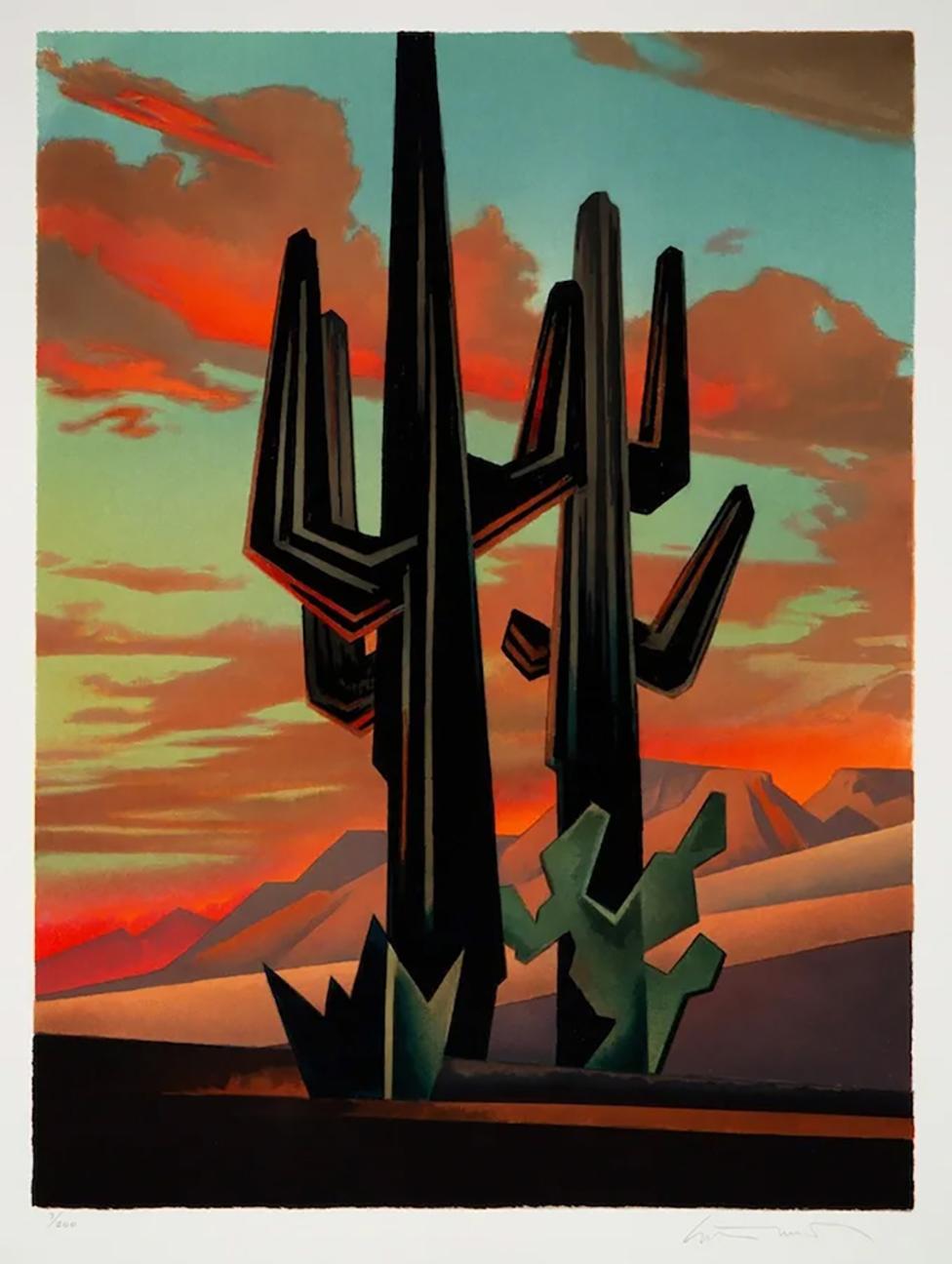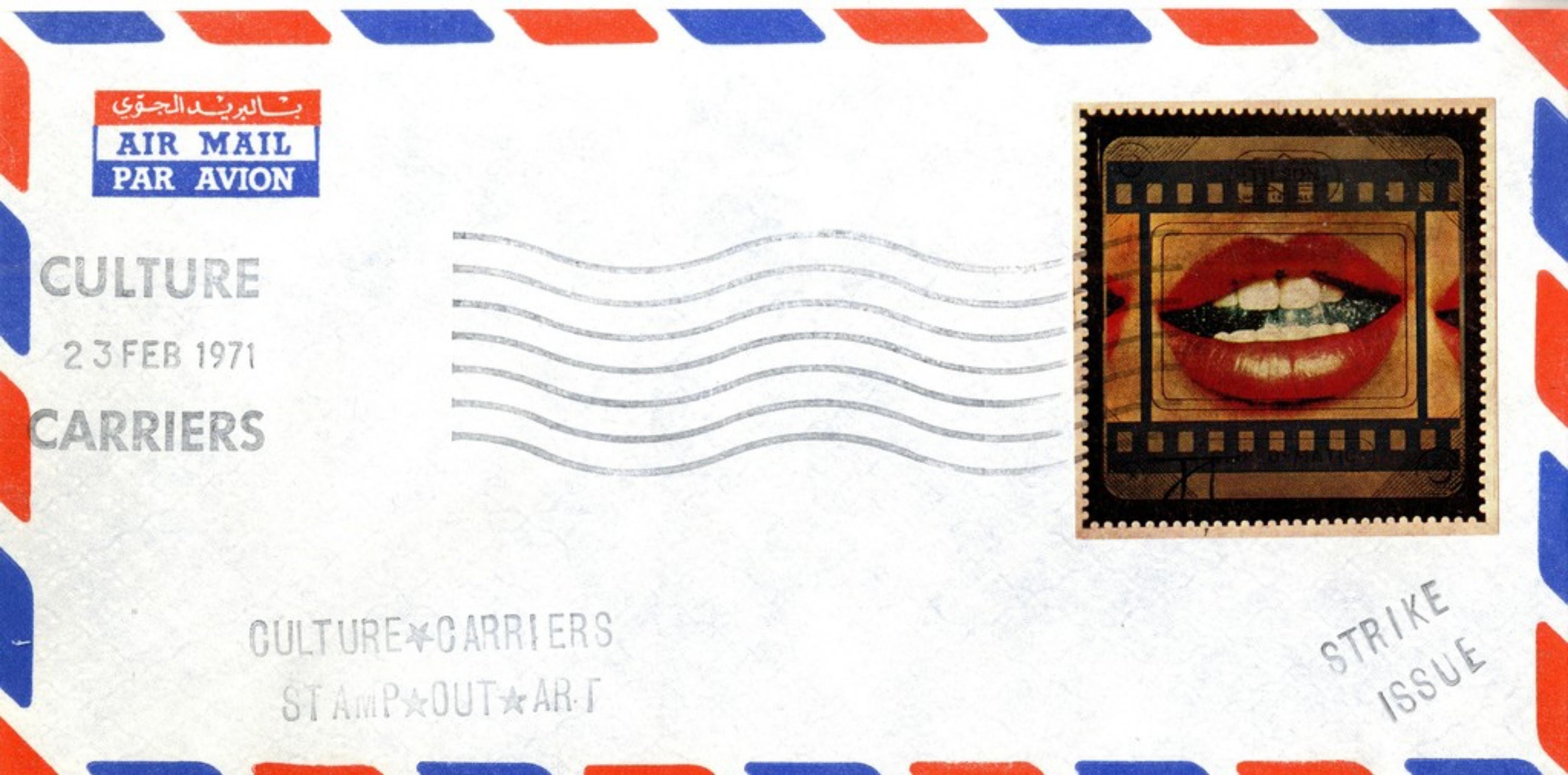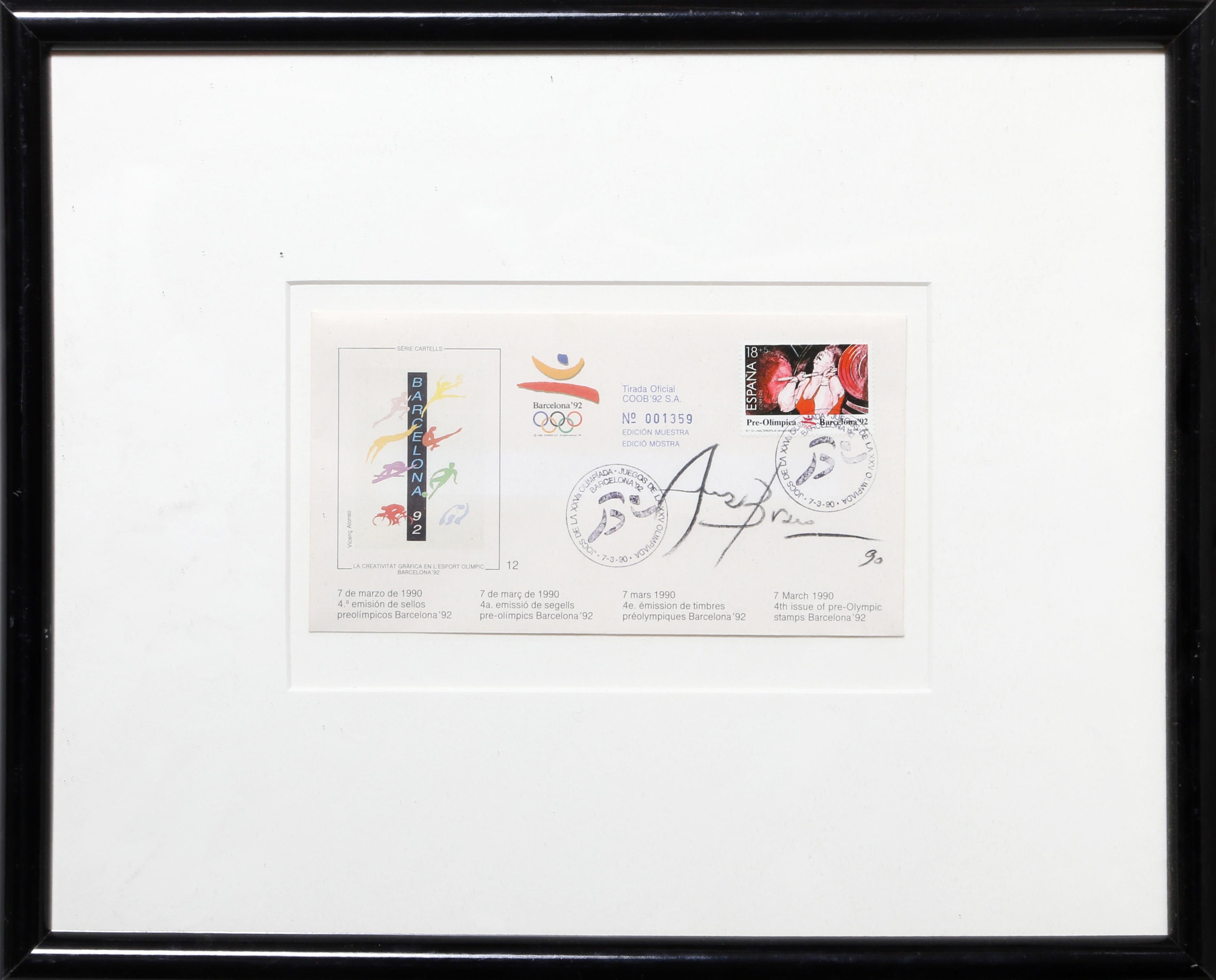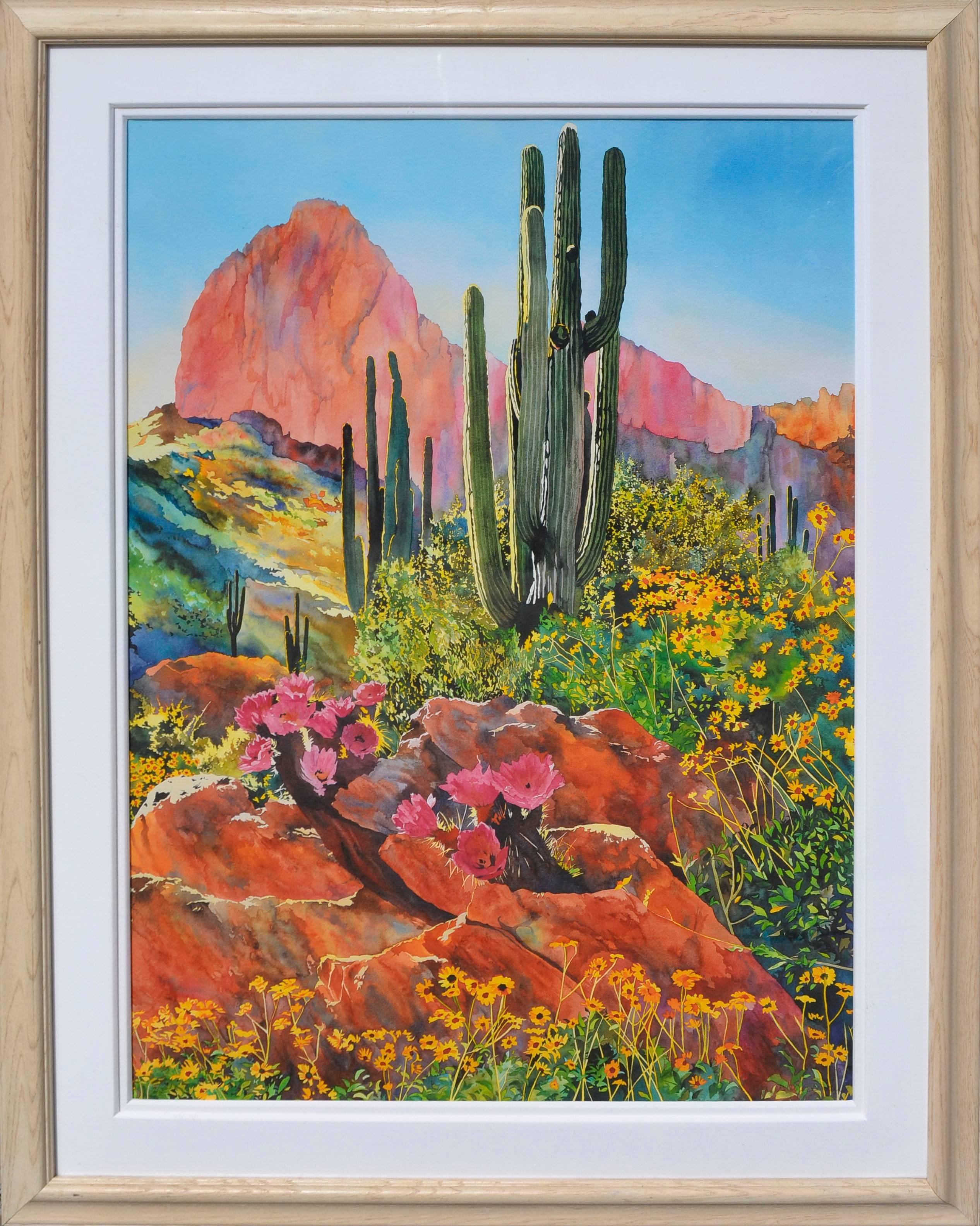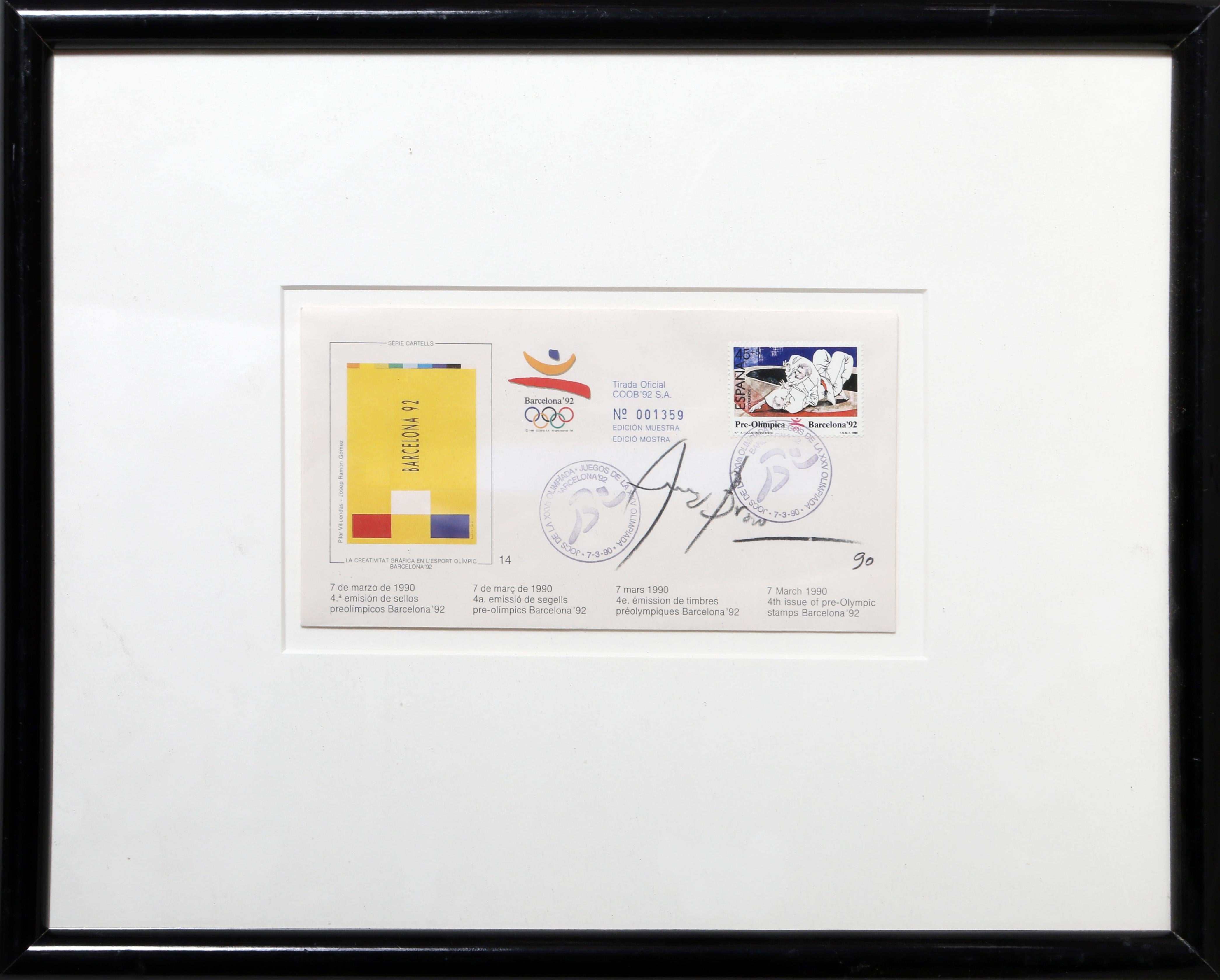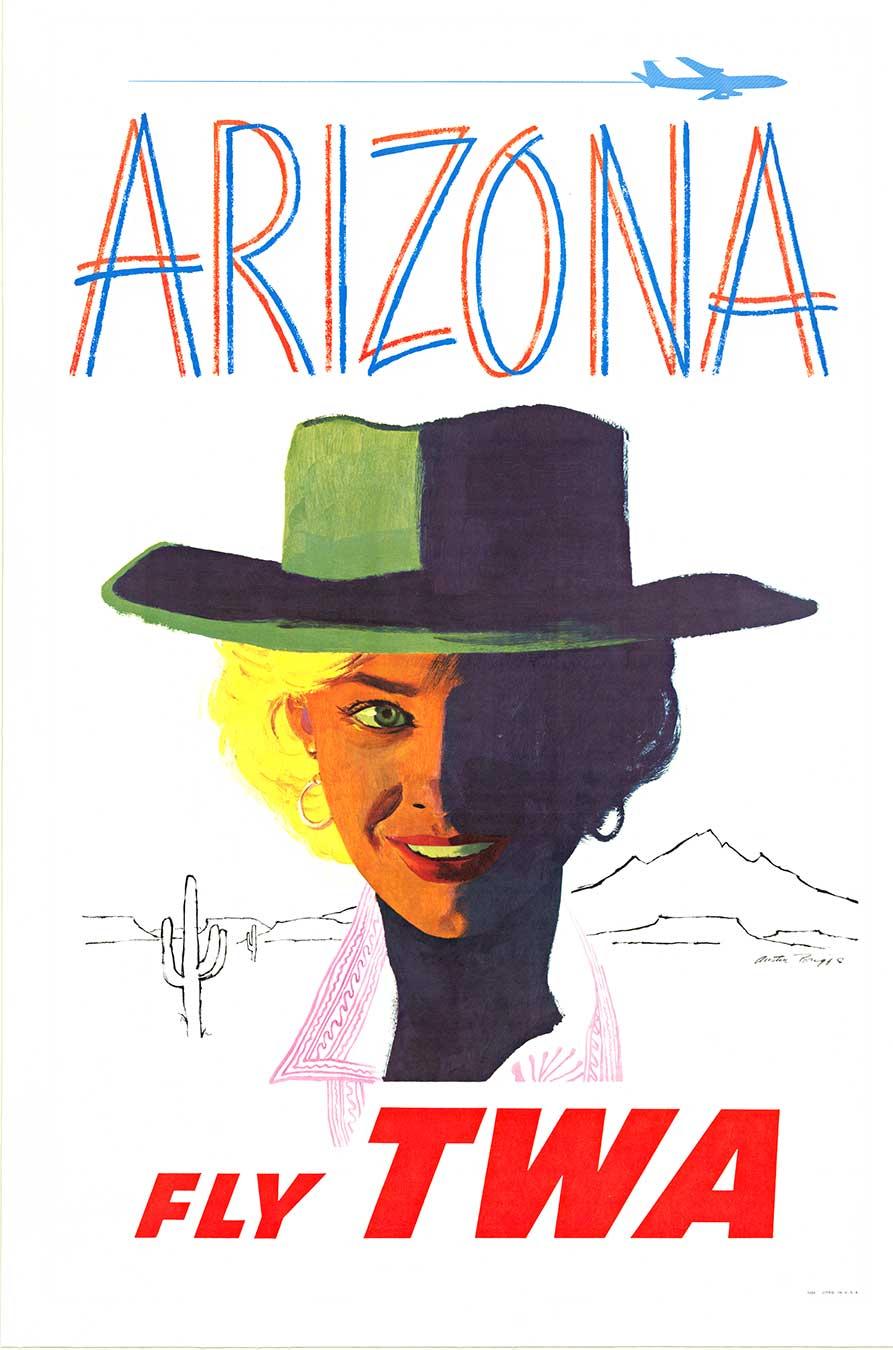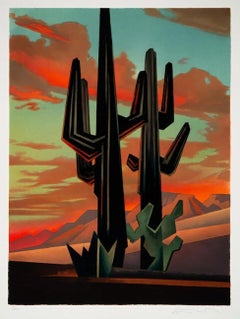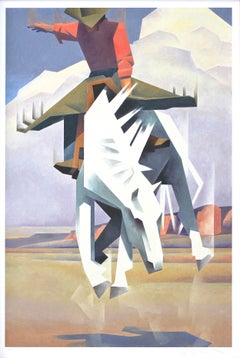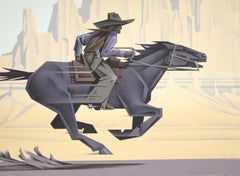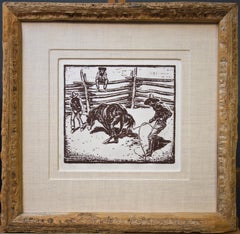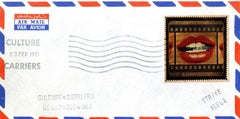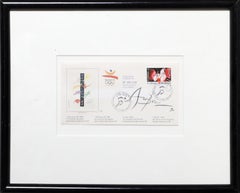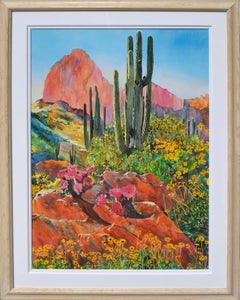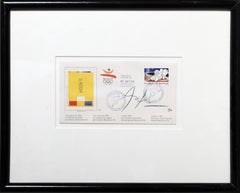Items Similar to Arizona Centennial First Day Issue Stamps and Envelope, autographed by Ed Mell
Want more images or videos?
Request additional images or videos from the seller
1 of 3
Ed MellArizona Centennial First Day Issue Stamps and Envelope, autographed by Ed Mell2012
2012
$600
£463.07
€527.18
CA$856.75
A$934.45
CHF 492.38
MX$11,206.56
NOK 6,199.64
SEK 5,784.14
DKK 3,937.08
About the Item
Ed Mell 1942-2024
Original signatures on stamps and envelope.
Custom presentation frame.
Arizona Centennial Commemorative Stamp, Arizona First Day of Issue by Ed Mell, 1942-2024. Custom frame with autographed stamps and First Day of Issue with Signature Frame, Desert tone finish 16 x 13 inches.
Arizona Centennial Commemorative Stamp History on back of frame.
The framing of the Arizona Statehood Stamp and the First Day of Issue envelope is presented with the Ed Mell signature frame with embossed signature on the side of the frame. The stamps and envelope are personally autographed by Ed Mell. The modern style frame is hand finished in a desert tone color and framed to archival standards and conservation glass (97% UV protection). Michael Collier, Collier Gallery
With this Arizona Statehood (Forever®) stamp, the U.S. Postal Service commemorates the 100th anniversary of one of America's last frontiers. Arizona became the 48th state in the Union on February 14, 1912. Also known as the "Grand Canyon State," it is home to 21 Native American tribes with ancient connections to a land known for its stunning beauty and abundant natural resources.
The 1848 Treaty of Guadalupe Hidalgo, which ended the U.S. - Mexican War, resulted in the United States acquiring most of the land that makes up present-day Arizona. Although Congress made Arizona a U.S. territory in 1863, achieving statehood would take nearly 50 years. Mineral riches and large federal irrigation projects helped transform the desert region into something closer to an economic oasis. Today, more than six million people live in Arizona. Phoenix, the state capital, is the largest city with approximately 1.5 million residents, followed by Tucson, which has a population of more than a half-million residents. Approximately one quarter of the state is set aside for Indian reservations, including the Navajo Reservation, the largest in the United States. Hispanics, part of the region's ethnic makeup since the 17th century, currently comprise 30 percent of the state's population.
The stamp art features an original painting by Phoenix Native Ed Mell, who worked with art director Richard Sheaff on its design. The stamp's painting features the colorful and much admired sandstone rock formations of Sedona, Arizona. This is the first stamp for Mell, who is well known for his distinctive modernist renderings of the Southwest desert landscape.
- Creator:Ed Mell (1942, American)
- Creation Year:2012
- Dimensions:Height: 16 in (40.64 cm)Width: 13 in (33.02 cm)
- Medium:
- Movement & Style:
- Period:
- Condition:
- Gallery Location:Phoenix, AZ
- Reference Number:1stDibs: LU2623215171252
About the Seller
No Reviews Yet
Vetted Professional Seller
Every seller passes strict standards for authenticity and reliability
1stDibs seller since 2023
8 sales on 1stDibs
- ShippingRetrieving quote...Shipping from: Phoenix, AZ
- Return Policy
More From This Seller
View AllSonoran Kings by Ed Mell
By Ed Mell
Located in Phoenix, AZ
"Sonoran Kings"
Ed Mell 1942-2024
Stone lithograph
32" x 24"
**PRINTS ARE ESTATE SIGNED WITH WITH EMBOSSED LOGO AND SIGNATURE STAMP***
Edition. 200, 2020
Print is unframed.
Biograp...
Category
21st Century and Contemporary Landscape Prints
Materials
Lithograph
Ed Mell, This Palomino Ain't No Pal of Mine, Giant Size, 54 x 36 in , Special Ed
By Ed Mell
Located in Phoenix, AZ
This Palomino Ain’t No Pal of Mine 1982
Giant Size, Special Limited Edition
Archival Pigment Print
Original Pencil Signature, Signed Lower Right
Made in collaboration with Ed Mell
...
Category
1980s Contemporary Figurative Prints
Materials
Digital
Full Speed Ahead by Ed Mell
By Ed Mell
Located in Phoenix, AZ
Full Speed Ahead 1985
Ed Mell 1942-2024
Original signature lower right
Stone Lithograph
22 x 30 inches
MINT CONDITION. NEVER FRAMED!
SHIPPING CHARGES INCLUDE SHIPPING, PACKAGING...
Category
1980s Figurative Prints
Materials
Lithograph
Bronc by Lon Megargee, Woodblock Print ca. 1920s with Handmade Saguaro Rib Frame
Located in Phoenix, AZ
SHIPPING CHARGES INCLUDE SHIPPING, PACKAGING & **INSURANCE**
Bronc by Lon Megargee, Woodblock Print ca. 1920s
Handmade Saguaro Rib Frame, double linen mat, museum archival materials
Bronc
Woodblock Print, signed in print
Image: 8 3/4 x 9 7/8 inches
Frame: 21 x 20 inches
SHIPPING CHARGES INCLUDES, SHIPPING, PACKAGING & INSURANCE
FINE ART ESTATE OF LON MEGARGEE
Megargee Custom Handmade Saguaro Frame
We offer signed in print and original signature block prints. Custom, hand carved, signature frames, with archival standards and a speciality in hand dyed mats and french matting are provided for a beautiful and timeless presentation.
Free shipping Continental US
Biography
Megargee explored different mediums; printmaking captivated him in particular. The contrast of the black and white block print method captured perfectly his interpretation of a bold American West. The first print was produced around 1921 and culminated with the creation of “The Cowboy Builds a Loop” in 1933 with 28 images and poetry by his friend, Roy George. Megargee continued producing prints throughout the 1940s and early 50s.
Creator of the iconic logo for the Stetson Hat Company, " Last Drop From his Stetson", still in use today.
Fine Art Estate of Lon Megargee
At age 13, Lon Megargee came to Phoenix in 1896 following the death of his father in Philadelphia. For several years he resided with relatives while working at an uncle’s dairy farm and at odd jobs. He returned to Philadelphia in 1898 – 1899 in order to attend drawing classes at the Pennsylvania Academy of the Fine Arts. Back in Phoenix in 1899, he decided at the age of 16 to try to make his living as a cowboy. Lon moved to the cow country of Wickenburg where he was hired by Tex Singleton’s Bull Ranch. He later joined the Three Bar Ranch . . . and, after a few years, was offered a job by Billy Cook...
Category
Early 20th Century Figurative Prints
Materials
Woodcut
Hopi by Lon Megargee, Original Signed Block Print ca. 1920s
Located in Phoenix, AZ
Title: Hopi ca. 1920s
Artist: Lon Megargee
Medium: Block Print
Size: 11 x 11 inches (Sight Measurement)
SHIPPING CHARGES INCLUDE SHIPPING, PACKAGING & INSURANCE
Creator of Stetson's hat logo "Last Drop from his Hat"
Image of Lon Megargee not included in purchase.
Lon Megargee
1883 - 1960
At age 13, Lon Megargee came to Phoenix in 1896 following the death of his father in Philadelphia. For several years he resided with relatives while working at an uncle’s dairy farm and at odd jobs. He returned to Philadelphia in 1898 – 1899 in order to attend drawing classes at the Pennsylvania Academy of the Fine Arts. Back in Phoenix in 1899, he decided at the age of 16 to try to make his living as a cowboy.
Lon moved to the cow country of Wickenburg, Arizona where he was hired by Tex Singleton’s Bull Ranch. He later joined the Three Bar R. . . and after a few years, was offered a job by Billy Cook of the T.T. Ranch near New River. By 1906, Megargee had learned his trade well enough to be made foreman of Cook’s outfit.
Never shy about taking risks, Lon soon left Cook to try his own hand at ranching. He partnered with a cowpuncher buddy, Tom Cavness, to start the El Rancho Cinco Uno at New River. Unfortunately, the young partners could not foresee a three-year drought that would parch Arizona, costing them their stock and then their hard-earned ranch.
Breaking with his romantic vision of cowboy life, Megargee finally turned to art full time. He again enrolled at the Pennsylvania Academy of Art and then the Los Angeles School of Art and Design during 1909 – 1910. The now well-trained student took his first trip to paint “en plein air” (outdoors) to the land of Hopi and Navajo peoples in northern Arizona. After entering paintings from this trip in the annual Territorial Fair at Phoenix, in 1911, he surprisingly sold his first oil painting to a major enterprise – the Santa Fe Railroad . . . Lon received $50 for “Navajos Watching the Santa Fe Train.” He soon sold the SFRR ten paintings over the next two years. For forty years the railroad was his most important client, purchasing its last painting from him in 1953.
In a major stroke of good fortune during his early plein-air period, Megargee had the opportunity to paint with premier artist, William R. Leigh (1866 – 1955). Leigh furnished needed tutoring and counseling, and his bright, impressionistic palette served to enhance the junior artist’s sense of color and paint application. In a remarkable display of unabashed confidence and personable salesmanship, Lon Megargee, at age 30, forever linked his name with Arizona art history. Despite the possibility of competition from better known and more senior artists, he persuaded Governor George Hunt and the Legislature in 1913 to approve 15 large, historic and iconic murals for the State Capitol Building in Phoenix. After completing the murals in 1914, he was paid the then princely sum of roughly $4000. His Arizona statehood commission would launch Lon to considerable prominence at a very early point in his art career.
Following a few years of art schooling in Los Angeles, and several stints as an art director with movie studios, including Paramount, Megargee turned in part to cover illustrations for popular Western story magazines in the 1920s.
In the 1920s, as well, Lon began making black and white prints of Western types and of genre scenes from woodblocks. These prints he generally signed and sold singly. In 1933, he published a limited edition, signed and hard-cover book (about 250 copies and today rare)containing a group of 28 woodblock images. Titled “The Cowboy Builds a Loop,” the prints are noteworthy for strong design, excellent draftsmanship, humanistic and narrative content, and quality. Subjects include Southwest Indians and cowboys, Hispanic men and women, cattle, horses, burros, pioneers, trappers, sheepherders, horse traders, squaw men and ranch polo players. Megargee had a very advanced design sense for simplicity and boldness which he demonstrated in how he used line and form. His strengths included outstanding gestural (action) art and strong figurative work. He was superb in design, originality and drawing, as a study of his prints in the Hays collection reveals.
In 1944, he published a second group of Western prints under the same title as the first. Reduced to 16 images from the original 28 subjects, and slightly smaller, Lon produced these prints in brown ink on a heavy, cream-colored stock. He designed a sturdy cardboard folio to hold each set. For the remainder of his life, Lon had success selling these portfolios to museum stores, art fairs and shows, and to the few galleries then selling Western art.
Drawing on real working and life experiences, Lon Megargee had a comprehensive knowledge, understanding and sensitivity for Southwestern subject matter. Noted American modernist, Lew Davis...
Category
1920s American Impressionist Figurative Prints
Materials
Woodcut
Bomber and Buckeroos by Till Goodan, Westward Ho Company
Located in Phoenix, AZ
Bomber And Buckeroos ca. 1939
Till Goodan
Offset Lithograph
PRINTS ARE IN GOOD CONDITION. PRINTS MAY HAVE SMALL FLAW ALONG EDGE OF PAPER, DOES NOT EFFECT THE PRINT IMAGE
All the prints are 26 x 31 inches, Mustang Peeler, Bombers and Buckaroos, The stranger, Guardians of the Range and Range Baby.
Note that “The Mustang Runner” is 3 inches shorter in height, 23 x 31 inches
The print by Till Goodan was originally a painting and reproduced by the Westward Ho company as a set. Westward Ho produced the most sought after Western dinnerware ever made. The most popular pattern was the Rodeo pattern by Till Goodan. He Illustrated and branded many accessories sold by the Westward Ho Company.
Tillman Parker Goodan 1896-1958
To the casual observer his paintings are exciting and colorful. To the scholars of the Western Era they are benchmarks of authenticity. Such is the style of Till Goodan. He was born Tillman Parker Goodan in Eaton, Colorado on March 27, 1896. His father was a true western pioneer, mayor of Eaton, publisher of its first newspaper, and County Commissioner for several years.
After moving to California in 1905 and settling on a little farm that bordered the Michel Cattle Ranch, Till spent much of his boyhood with the Michel sons working on their ranch. There he developed his expertise as a calf roper and the skills of a working cowboy.
As a young man Till pursued endeavors that would initially callous his emerging artistic hands. He worked for the famous Miller and Lux Ranch in California. He packed mules and ran pack trains into the Sierra Mountains. He broke horses and competed in local rodeos riding saddle broncs and roping calves. And during the quiet hours he would draw pictures of ranch life and the action of the rodeo. People began commenting on his talents as an artist.
In 1917 he left the rodeo circuit and turned his full attention to a career in art. He studied with Roger Sterrett, William Paxton, and Dana Bartlett, all highly respected California artists. Till soon became a free-lance commercial artist doing work for Grauman’s Chinese and Lowe’s Theaters, Helms Bakery and Security Bank. He later assumed a position as Art Director for the Richfield Oil Company. However, his first love was still the art of the old west, horses, cowboys, and ranching. So, he left Richfield and gave his full attention to the field of fine arts.
He did oil painting, water colors and lithographs. He drew the Gene Autry Comic Books. He illustrated and hand lettered a large collection of stories about famous bucking horses, ranches, horsemen of the world, and western gear. In association with W.C. Wentz, he started producing a complete line of western gift wares, ceramics, bronzes, leather, paper, and fabric.
By the 1930′s he was beginning to receive recognition for his western art and by the early 1940s, he and his daughter, Betty, were illustrating comic books for his longtime friend, Gene Autry. Betty was also a world champion cowgirl.
Till Goodan designs appeared in virtually every medium. But, the most famous was the four lines of dinnerware produced by Wallace China...
Category
1930s American Impressionist Figurative Prints
Materials
Lithograph
You May Also Like
Culture Carriers Stamp Out Art (Lt. Ed. hand signed stamp on franked envelope)
By Joe Tilson
Located in New York, NY
JOE TILSON
Culture Carriers Stamp Out Art (Hand Signed), from the Collection of Art Critic Anthony Haden-Guest, 1971
Lithograph mounted on franked Air...
Category
1970s Pop Art Mixed Media
Materials
Mixed Media, Lithograph, Ink, Offset
Barcelona Pre-Olympic Stamp 2, Mixed Media on Paper by Eduardo Arranz-Bravo
By Eduardo Arranz-Bravo
Located in Long Island City, NY
Pre-Olympic stamps created for the ‘92 Barcelona Olympics by Spanish artist Eduardo Arranz Bravo.
Barcelona Pre-Olympic Stamp 2
Eduardo Arranz-Bravo, Spanish (1941)
Date: 1990
Mixed...
Category
1990s Mixed Media
Materials
Paper, Mixed Media
Desert Spring Landscape
By Laurie Bender
Located in Soquel, CA
Vivid large scale giclee print, 27/95, titled Desert Spring 1996 by Laurie Bender (American, b. 1953). Displayed double linen mat and whitewashed wood frame. Signed lower right and n...
Category
1990s American Impressionist Landscape Prints
Materials
Paper, Giclée
Barcelona Pre-Olympic Stamp 3, Mixed Media on Paper by Eduardo Arranz-Bravo
By Eduardo Arranz-Bravo
Located in Long Island City, NY
Pre-Olympic stamps created for the ‘92 Barcelona Olympics by Spanish artist Eduardo Arranz Bravo.
Barcelona Pre-Olympic Stamp 3
Eduardo Arranz-Bravo, Spanish (1941)
Date: 1990
Mixed...
Category
1990s Mixed Media
Materials
Paper, Mixed Media
Original ARIZONA - Fly TWA (Airlines) vintage travel poster, Austin Briggs
By Austin Briggs
Located in Spokane, WA
Original ARIZONA, Fly TWA (Airlines) vintage travel poster. Archival linen backed in excellent condition, ready to frame. Grade A. Images shown are of the exact poster you will ...
Category
1950s American Modern Portrait Prints
Materials
Offset
Barcelona Pre-Olympic Stamp 1, Mixed Media on Paper by Eduardo Arranz-Bravo
By Eduardo Arranz-Bravo
Located in Long Island City, NY
Pre-Olympic stamps created for the ‘92 Barcelona Olympics by Spanish artist Eduardo Arranz Bravo.
Barcelona Pre-Olympic Stamp 1
Eduardo Arranz-Bravo, Spanish (1941)
Date: 1990
Mixed...
Category
1990s Mixed Media
Materials
Paper, Mixed Media
